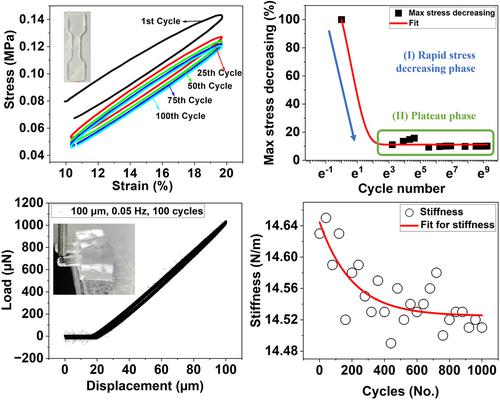当前位置:
X-MOL 学术
›
J. Appl. Polym. Sci.
›
论文详情
Our official English website, www.x-mol.net, welcomes your
feedback! (Note: you will need to create a separate account there.)
Multiscale mechanics of polydimethylsiloxane: A comparison of meso‐ and micro‐cyclic deformation behavior
Journal of Applied Polymer Science ( IF 2.7 ) Pub Date : 2024-04-06 , DOI: 10.1002/app.55546 Lihua Lou 1 , Nicole Bacca 1 , Marshall S. Ma 2, 3 , Pranjal Nautiyal 1 , Thomas G. Bifano 2, 3 , Arvind Agarwal 1
Journal of Applied Polymer Science ( IF 2.7 ) Pub Date : 2024-04-06 , DOI: 10.1002/app.55546 Lihua Lou 1 , Nicole Bacca 1 , Marshall S. Ma 2, 3 , Pranjal Nautiyal 1 , Thomas G. Bifano 2, 3 , Arvind Agarwal 1
Affiliation

|
Despite plenty of static and dynamic mechanical measurements and modeling for bulk polydimethylsiloxane (PDMS) specimens, a notable gap exists in comprehensively understanding the dynamic mechanics under large cycle, low strain conditions, especially for microscale samples. This study integrates tensile testing and nanoindentation techniques to compare dynamic mechanical response for bulk PDMS samples and μ‐pillars. The results from cyclic tensile testing, which involved up to 10,000 cycles at a strain range of 10%–20%, indicate a stabilization of energy dissipation rate after the initial 25 cycles. This attributes to stress relaxation and strain hardening, validating by rapid dual‐phase exponential decay in maximum stress, coupled with an incremental increase in elastic modulus. In comparison to tensile testing, μ‐pillars exhibited a 0.82% reduction in stiffness, stabilizing ~600th cycle. Concurrently, there was an approximately twofold increase in approaching distance during the initial 120 cycles, and an approximately fourfold increase in dissipated energy over the first 80 cycles, before reaching a plateau. This lagging hysteresis effect attributes to the distribution of the resultant force, including top tension, bottom compression, and base tilt. Overall, this study illuminates temporal mechanical deformations in PDMS under two application scenarios, enhancing our understanding of PDMS mechanical behavior.
中文翻译:

聚二甲基硅氧烷的多尺度力学:介观和微观循环变形行为的比较
尽管对块状聚二甲基硅氧烷(PDMS)样品进行了大量的静态和动态力学测量和建模,但在全面理解大循环、低应变条件下的动态力学方面仍存在显着差距,特别是对于微型样品。本研究集成了拉伸测试和纳米压痕技术,以比较块状 PDMS 样品和 μ 柱的动态机械响应。循环拉伸测试在 10%–20% 的应变范围内进行了多达 10,000 次循环,结果表明在最初 25 次循环后能量耗散率趋于稳定。这归因于应力松弛和应变硬化,通过最大应力的快速双相指数衰减以及弹性模量的增量增加来验证。与拉伸测试相比,μ 柱的刚度降低了 0.82%,稳定了第 600 次循环。同时,在最初的 120 个循环中,接近距离增加了大约两倍,在前 80 个循环中,耗散能量增加了大约四倍,然后达到稳定水平。这种滞后效应归因于合力的分布,包括顶部张力、底部压缩和底部倾斜。总的来说,这项研究阐明了 PDMS 在两种应用场景下的时间机械变形,增强了我们对 PDMS 机械行为的理解。
更新日期:2024-04-06
中文翻译:

聚二甲基硅氧烷的多尺度力学:介观和微观循环变形行为的比较
尽管对块状聚二甲基硅氧烷(PDMS)样品进行了大量的静态和动态力学测量和建模,但在全面理解大循环、低应变条件下的动态力学方面仍存在显着差距,特别是对于微型样品。本研究集成了拉伸测试和纳米压痕技术,以比较块状 PDMS 样品和 μ 柱的动态机械响应。循环拉伸测试在 10%–20% 的应变范围内进行了多达 10,000 次循环,结果表明在最初 25 次循环后能量耗散率趋于稳定。这归因于应力松弛和应变硬化,通过最大应力的快速双相指数衰减以及弹性模量的增量增加来验证。与拉伸测试相比,μ 柱的刚度降低了 0.82%,稳定了第 600 次循环。同时,在最初的 120 个循环中,接近距离增加了大约两倍,在前 80 个循环中,耗散能量增加了大约四倍,然后达到稳定水平。这种滞后效应归因于合力的分布,包括顶部张力、底部压缩和底部倾斜。总的来说,这项研究阐明了 PDMS 在两种应用场景下的时间机械变形,增强了我们对 PDMS 机械行为的理解。


















































 京公网安备 11010802027423号
京公网安备 11010802027423号